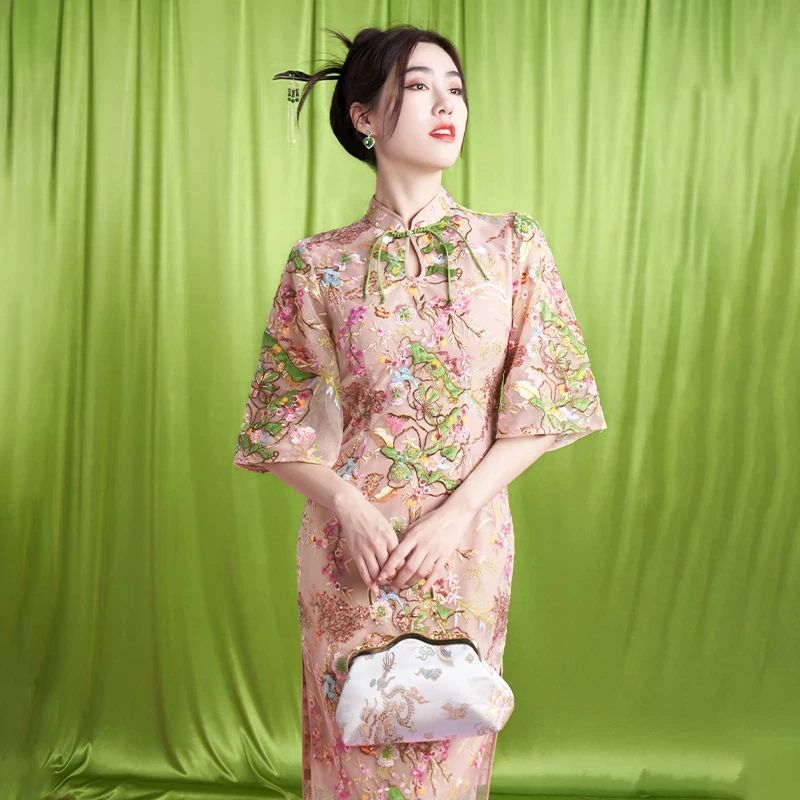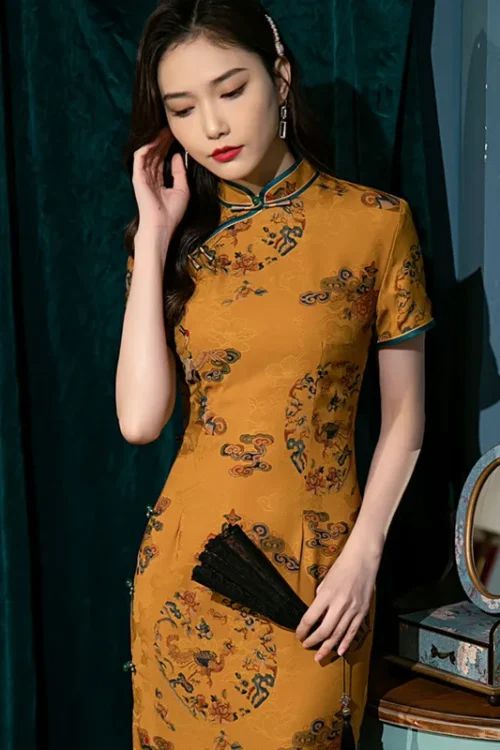The Qipao‘s Historical Roots: Exploring Its Origins and Cultural Significance
The qipao, an iconic Chinese dress, has undergone a remarkable evolution from its historical roots to its contemporary status as a sustainable fashion statement. Originating in the 1920s as a modernized version of the traditional Manchu robe, the qipao quickly gained popularity among urban women in China and beyond. Its form-fitting silhouette, high neckline, and intricate embroidery showcased the wearer’s elegance and femininity.

Evolution Through Decades
Over the decades, the qipao has evolved to reflect changing social and cultural norms. During the Republican era, it became a symbol of national pride and modernity, often adorned with patriotic motifs. In the 1950s, the qipao was adapted for everyday wear, with simpler designs and more practical fabrics. However, during the Cultural Revolution, it was suppressed as a symbol of bourgeois decadence.
Resurgence in Popularity
In recent years, the qipao has experienced a resurgence in popularity, both in China and internationally. Contemporary designers have reinterpreted the classic design, incorporating sustainable materials and innovative techniques. The use of organic fabrics, such as silk and cotton, reduces the environmental impact of production. Additionally, designers are exploring zero-waste patterns and upcycling techniques to minimize fabric waste.
Cultural Heritage and Sustainability
The qipao’s evolution into a sustainable fashion statement reflects a growing awareness of environmental responsibility in the fashion industry. By embracing sustainable practices, designers are preserving the cultural heritage of the qipao while also contributing to a more sustainable future. Moreover, the qipao’s versatility and timeless appeal make it a perfect canvas for expressing individual style and cultural identity.
Conclusion
Today, the qipao is not only a historical garment but also a symbol of cultural pride and sustainable fashion. Its enduring popularity is a testament to its adaptability and the enduring appeal of Chinese aesthetics. As designers continue to innovate and explore new possibilities, the qipao is poised to remain a vibrant and relevant fashion statement for generations to come.
The Qipao’s Modern Evolution: Adaptations and Innovations in Contemporary Fashion
The qipao, an iconic Chinese dress, has undergone a remarkable evolution from its historical roots to its contemporary status as a sustainable fashion statement. Originating in the 1920s as a symbol of modernization and female empowerment, the qipao has since been reinterpreted and adapted to reflect changing societal norms and fashion trends.

Early 20th Century Revolution
In the early 20th century, the qipao emerged as a revolutionary garment that challenged traditional gender roles. Its form-fitting silhouette and high slits allowed women to move freely and express their individuality. As China embraced Western influences, the qipao became a symbol of modernity and progress.
Adaptations Over the Decades
Over the decades, the qipao has undergone numerous adaptations. In the 1950s, it was simplified and standardized to align with the socialist ideals of the time. In the 1980s, as China opened up to the world, the qipao experienced a revival and was reintroduced into mainstream fashion.
Contemporary Interpretations
Contemporary designers have embraced the qipao’s versatility, reinterpreting it in various ways. Some have retained its traditional elements, such as the high collar and side slits, while others have experimented with new fabrics, colors, and patterns. The qipao has also been incorporated into fusion designs, blending Chinese aesthetics with Western influences.
Sustainability in Fashion
In recent years, sustainability has become a key consideration in fashion. The qipao has emerged as a sustainable choice due to its timeless design and durability. Its classic silhouette can be worn for multiple occasions, reducing the need for excessive consumption. Additionally, designers are exploring sustainable materials, such as organic cotton and recycled fabrics, to create eco-friendly qipaos.
Conclusion
The qipao’s evolution reflects the changing social and cultural landscape of China. From its origins as a symbol of female empowerment to its contemporary status as a sustainable fashion statement, the qipao continues to captivate and inspire. Its adaptability and versatility ensure its enduring relevance in the world of fashion.
The Qipao’s Sustainable Transformation: Embracing Eco-Friendly Practices and Ethical Production
The qipao, an iconic Chinese dress, has undergone a remarkable evolution, transforming from a historical garment to a sustainable fashion statement. Its journey has been marked by a fusion of tradition and modernity, with designers embracing eco-friendly practices and ethical production methods.

Cultural Identity and Historical Significance
Historically, the qipao was a symbol of Chinese culture and identity. Its form-fitting silhouette and intricate embroidery showcased the wearer’s elegance and femininity. However, as fashion trends evolved, the qipao faced a decline in popularity.
Resurgence and Cultural Preservation
In recent years, there has been a resurgence of interest in the qipao, driven by a desire for cultural preservation and a growing appreciation for sustainable fashion. Designers have reimagined the traditional garment, incorporating sustainable materials and ethical production practices.
Eco-Friendly Fabrics
One of the key aspects of the qipao’s sustainable transformation is the use of eco-friendly fabrics. Designers are opting for organic cotton, bamboo, and recycled materials to reduce their environmental impact. These fabrics are not only biodegradable but also offer comfort and breathability.
Ethical Production Practices
Ethical production is another crucial aspect of the qipao’s sustainable evolution. Designers are partnering with fair-trade organizations and ensuring that their workers are treated fairly and paid a living wage. This approach promotes social responsibility and ensures that the qipao’s production aligns with ethical values.
Innovative Waste Reduction
Furthermore, designers are exploring innovative ways to reduce waste and minimize their carbon footprint. They are using zero-waste pattern cutting techniques and upcycling discarded fabrics to create unique and sustainable pieces.
Conclusion
The qipao’s sustainable transformation has not only preserved its cultural significance but has also made it a symbol of environmental consciousness. By embracing eco-friendly practices and ethical production, designers are creating a new generation of qipaos that are both stylish and sustainable.
As the qipao continues to evolve, it is likely to become an even more prominent symbol of cultural heritage and sustainable fashion. Its journey serves as a testament to the power of innovation and the importance of preserving tradition while embracing modern values.
